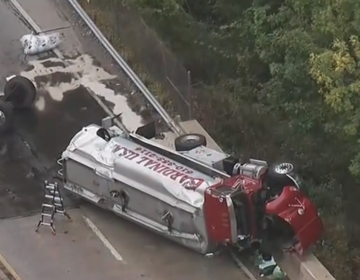What are you actually supposed to do when you get a tornado warning?
Safety experts recommend taking shelter when you get the alert on your phone — and seeking out more information when possible.

A tornado touched down in Delaware County on Halloween (NBC10)
Late Thursday night, many in the Philadelphia region were awakened by alerts on their cellphones like this one:
“Emergency Alert 11.32pm
NWS:TORNADO WARNING in this area till 12.00 AM EDT. Take shelter now. Check media.”
Some rolled over and went back to sleep.
Others rushed to their basements.
And still others wondered, “OK, so … what am I supposed to do now?”
Simple answer, said Montgomery County Outreach Coordinator Tim Elberston: Heed the warning.
“There’s a reason you’re getting an alert,” he said. “It’s not such a broad-brush advisory anymore. It’s saying, ‘Look, this is a specific geographic area that is under a specific threat. Please listen to what we’re saying and take action.’”
Alex Staarmann, a meteorologist with the National Weather Service in Mount Holly, New Jersey, said a tornado warning is, indeed, serious business.
“When a tornado warning is issued, that means that there’s solid evidence — at least on radar, if not already confirmed from a spotter or some other source — that a tornado is either on the ground or is imminent,” he said.
That specificity is something the National Weather Service has worked to improve. Whereas many years ago, the NWS might issue a warning for an entire county, now — as happened Thursday night — it pinpoints areas identified as being at risk.
If you happen to live in one of those areas, you should take cover.
“Get into the basement of your home,” Elbertson said. “If you don’t have a basement, you look for a room that’s in the interior part of your house, preferably without any windows.”
That means someplace like an interior hallway or a closet beneath a flight of stairs — any place that will put as many walls as possible between you and the storm outside.
Elbertson said it’s only natural that some people don’t take the warnings seriously.
“I think it catches a lot of people off guard when it’s late at night and you think, ‘Oh, we don’t normally get weather like that here in Southeastern Pennsylvania,’” he said. “But it can happen. Wind is a strange thing, and it can do lots of damage when we least expect it. You don’t need to have that mile-wide, `Wizard of Oz’ tornado to do damage in your community.”
Pennsylvania may not seem like tornado country, but Staarmann the state gets an average of 16 tornadoes per year.
“They’re not as frequent as like you would get in the Plains or the Midwest,” he said, “but it’s certainly a threat that we deal with on a yearly basis in this part of the country.”
Residents of Thornbury Township in Delaware County are now part of that statistic. An EF-2 tornado ripped through their community late Thursday, destroying eight homes and displacing some 20 residents in the middle of the night, their homes battered by winds ranging from 111 to 135 mph. The Weather Service considers that to be a “strong” tornado.
“For this region of the country, [EF-2 tornadoes] are not all that common,” Staarmann said, “but several of them have occurred within the last few decades.”
The National Weather Service distinguishes between a “tornado watch” and a “tornado warning.”
A watch means be prepared: Tornadoes are possible in and near the watch area.
A warning, however, means you should take action because a tornado has been identified on the weather radar, and there is “imminent danger to life and property.”
Elbertson said sometimes the warnings come too late.
“Sometimes, tornadic activity spins up quickly,” he said, “and if you happen to be underneath it, you may not get an official alert until it’s already happened. That happens everywhere, because nature is unpredictable.”
But if you do get a warning on your phone, he said, take it seriously because the wind intensity could cause a tree to fall on the house or windows to blow in.
“You don’t want to be anywhere near that,” he said.
Tornadoes 508 by WHYY News on Scribd
WHYY is your source for fact-based, in-depth journalism and information. As a nonprofit organization, we rely on financial support from readers like you. Please give today.





